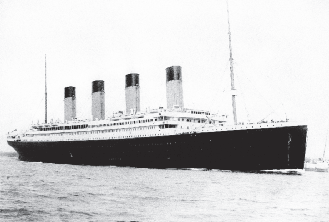Gerda Butkuvienė.
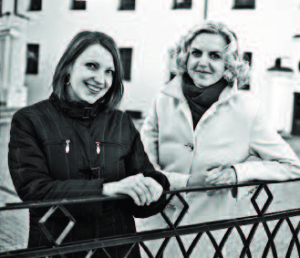
It has now been 104 years since the sinking of this legendary ocean cruise liner. The memory of the tragedy refuses to fade as a successor liner, the “Titanic II”, is being readied for launch, because difficult-to-answer questions about the disaster continue to be raised and discussed. In a book titled “Titaniko lietuviai” by Vaida Lowell and myself, a new twist to the well known story was added – the role played by several persons of Lithuanian descent, as victims, survivors or potential rescuers in the events that unfolded on April 12, 1915.
The RMS “Titanic” was the largest and most expensive 20th century transatlantic liner. It was referred to as a “small city on the water.” Construction of the ship was begun in 1909 in Belfast, Ireland. The design included 10 decks, 2,000 windows on 11 levels, 4 elevators, 50 telephone lines, two promenades for strolling, 4 dining halls, 3 restaurants, a cafÈ, several hairdressing salons, a flower shop, a photo developing lab, a hospital complete with operating suite, a heated swimming pool with Turkish steam room, a sports facility, a library, and 762 guest rooms. Together with the ship personnel, the number of passengers being carried on its fateful voyage was slightly more than 2,000. At full capacity the boat was designed to accommodate 3,500 people, and so the “Titanic” was not considered to be overcrowded. Although the ship was equipped with only 20 lifeboats, their number was judged to be adequate according to rules in place at the time, which set the number of lifeboats based on the weight of a ship, and not on the anticipated numbers of passengers. These rules were later changed, but only after the liner’s catastrophic sinking.
As a result of the collision of the “Titanic” with an iceberg, more than 1,500 people died. Not many know that the largest cemetery dedicated to the victims is found in the Canadian port city of Halifax, a 2-hour flight from New York City or Toronto. Halifax was closest to the site of the maritime disaster, and it was from this port that the “Mackay-Bennett” was dispatched to recover any remains. More than 300 bodies were found, of which 119 were accorded a burial at sea, and 209 were taken back to Halifax for further identification. A fourth of the victims’ bodies were claimed by relatives, while the remainder were buried according to their religious faith: atheists in “Fairview Lawn” cemetery, Jews in “Baron de Hirsch,” and Catholics in “Mount Olivet.” Identical black granite tombstones were supplied by the White Star Line shipping company, owners of the “Titanic,” engraved with the name of the deceased and the date of the tragedy. Not a single name of Lithuanian origin can be found on these gravemarkers.
Juozas Montvila – Lithuanian priest and one of the heroes of the disaster
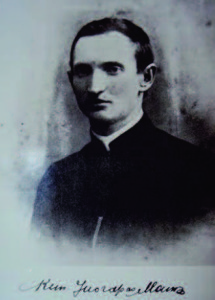
Liubavas is a hamlet of about 300 inhabitants in the eldership of Kalvarija. It’s located in the Marijampolė region, quite close to the border of Lithuania with Poland. In 2012, while the world was marking the 100-year anniversary of the sinking of the “Titanic”, in Liubavas, a wayside shrine was erected in remembrance of the victims of the tragedy. Carved into the granite base of the memorial was the inscription: “To Fr. Juozas Montvila, (1885-0103 – 1912-04-15 in the Atlantic ocean), who fostered and spread Lithuanian culture, and who was a notable son of Sūduva, and a hero and chaplain of the ‛Titanic.’ ” The memorial stands not far from the old church at Liubavas, where Fr. Montvila had served as vicar in 1910–1911.
We know that Fr. Montvila, raised near Marijampolė, was a passenger on the “Titanic” during its fateful voyage. He was traveling to the United States hoping to continue his pastoral mission, because the Russian czar ruling Lithuania had forbidden him to continue serving as a pastor after he had provided services to several members of the Ukrainian Orthodox Church. For a time, he worked in the Seinai region (now a part of Poland), helping to illustrate Catholic newspapers.
Fr. Juozas was the oldest of 8 siblings. He was planning to visit his brother Petras, who had moved to America 5 years previously. That family reunion would never take place. Fr. Montvila’s last letter to his brother Petras was sent from London on April 2: “I’m here in London now for a second week. Right after Easter, I’m planning to visit you. At home all are alive and well. Here in London the cherry trees have long since blossomed. The weather is a bit strange – neither warm nor cold. (…) With kisses, your brother, Fr. J. Montvila.” Once he obtained his ticket for the voyage, Fr. Juozas was quite happy; he had been afraid of becoming seasick during the passage, and the likelihood that he would need to worry about an upset stomach on the world’s largest ocean liner would be small.
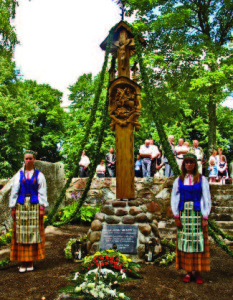
After the tragedy, a number of survivors would describe how 27 year old Montvila, along with 2 other priests on the voyage, declined to be seated in the lifeboats so they could minister to those remaining on the doomed ship, hearing their final confessions. In the movie “Titanic” by James Cameron, a priest is shown giving solace to the passengers of the sinking liner, but this particular character is identified as an English priest who was also present on the boat, Fr. Thomas Byles. Fr. Montvila’s suitcase contained a book of Lithuanian songs compiled by brothers Antanas and Jonas Juška, that Fr. Juozas was planning on publishing in the United States. This book was among the artifacts recently recovered from the wreckage site at the bottom of the Atlantic ocean.
The Titanic Relief Fund compensated the families of the victims. A payment of 130 pounds sterling to Fr. Montvila’s parents, Kazys and Magdalena, and to his grandparents. Fr. Montvila is remembered not only by the wayside shrine erected at Liubavas, but also by a biographical essay published by his brother Petras in 1977 titled “When the Past Returns.” Another brother, Andrius, sponsored the creation of a medallion in Fr. Juozas’ honor, which was ensconced in the wall of the Church of the Archangel Michael in Marijampolė. A copy of the medallion is on display at the Lithuanian church in London, Ontario, Canada.
Eliezer Gilinski – Litvak machinist from Ignalina
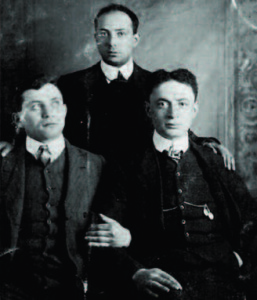
Fr. Montvila was booked in second class, so it would have been unlikely for him to encounter another Lithuanian passenger on the boat – Eliezer Gilinski – who had purchased a third class ticket.
“Body no. 47. Male. Age – about 30 years. Hair – dark. Clothes – grey coat, vest, and pants; green shirt. Personal belongings – photos; tickets; 5 dollar receipt; baggage indemnification certificate; 12 pounds sterling, 60 cents, 4 pence; keys; wallet; English language beginner’s guide; third class ticket No. 14973. Name: Leslie Gelinski.”
Such was the post-mortem identification card describing Eliezer Gilinski, a 22 year old machinist from Ignalina, who had boarded the “Titanic” at Southampton on April 10, 1912. According to some sources, Eliezer, a Lithuanian Jew, was sailing to Chicago to attend his brother’s wedding. He himself was not married. He was part of a large family, with one sister and four brothers. According to others, Eliezer was fleeing Lithuania to avoid the fate of his father, who had been forced to serve in the Russian army for 25 years. His family members maintained that Eliezer was being sought in Lithuania for avoiding military service.
His body was recovered by the “Mackay-Bennet” after the tragedy. Although most of bodies of third class passengers that were recovered were returned to Halifax, Eliezer’s body was given a burial at sea on April 21, 1912.
Simas Baniulis – incognito crew member?
Simas Baniulis is the name of a third victim of the “Titanic” disaster. It is thought that he was a member of the ship’s crew, his name is not listed on the official ship roster. He probably was working under an assumed name while fleeing conscription into the czar’s army. His story was investigated by historian Pranas Juozapavičius from Kaunas, but the only definitive information that could be obtained pointed to a young man from Sūduva who had some degree of education. It is possible that his remains were never properly identified, and that Simas was interred in one of the three Halifax cemeteries with the other victims.
Liudas Stulpinas – captain of the ship “Birma”
The boat nearest to the “Titanic” at the time of its sinking was the “Carpathia,” and it was this ship that first attempted to rescue survivors from the frigid waters or lifeboats. The “Carpathia” arrived within an hour or so after the “Titanic” had plunged into the ocean. The “Carpathia” collected all of the survivors it could find and then informed other ships in the area that their help would no longer be needed. Among the latter was the steamship “Birma,” which was among the first to receive the SOS signal from the “Titanic.” The captain of the “Birma” was a Lithuanian – Liudas Stulpinas!
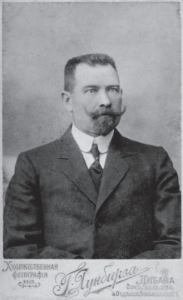
Born in 1871 at Jomantai, into a noble family, Stulpinas received training in maritime studies and was hired to crew on the steamships “Estonia” and “Lithuania” owned by the Russian East Asiatic Shipping Company. In 1909, he assumed the responsibilities of captain on the company’s larger ships, including the “Russia” and the “Birma”.
The “Birma” left New York for Rotterdam on April 11th, barely 3 hours after the “Carpathia.” Three days and 23 hrs. after the ship’s departure, the telegraph operator on the “Birma” received the first distress message from the “Titanic,” informing all surrounding ships that the “Titanic” had hit an iceberg and was sinking rapidly. Captain Stulpinas ordered an immediate change of course to the north and communicated that it was coming to help at full steam ahead. The “Titanic” responded with thanks. At the time, the “Birma” was almost 200 km. from the site of the disaster. En route, the crew of the “Birma” began preparations to house and feed the anticipated survivors. Food was made ready, bread was baked, and rooms, clothes, and blankets were organized. But at 1:30 AM, the “Birma” received a desperate second communication from the “Titanic,” that women and children had already been seated in lifeboats, and that the liner itself with remaining passengers and crew was sinking rapidly. There was no further reply from the “Titanic” to follow-up inquiries from the “Birma.”
Soon thereafter, the crew of the “Birma” was informed that the “Carpathia” was on-site recovering survivors. The “Birma” offered further assistance, but the offer of help was declined. The “Birma” then spent the next hours informing nearby ships about the large, floating icebergs in the area in order to avoid further mishaps. On the morning of April 15th, crew members from the “Birma” took photographs of a large, floating iceberg with a smashed-in side – a mark believed to have been left by its collision with the “Titanic.”
After the Klaipėda region was returned to Lietuva, Stulpinas took up the position of harbormaster and harbor captain. He was, in fact, the first seaman to receive the title of Lithuanian Sea Captain from the government. Stulpinas is buried in the village of Smiltynė, on the northern tip of the Curonian spit, from where he can forever gaze out over his beloved Baltic Sea.
Still other Lithuanians? Antanas Mickevičius saved by a tractor tire?
When writing the book “Titanikos lietuviai,” Vaida Lowell and I were careful to limit our narrative to well-documented cases of Lithuanians who may have been on board – notably the 3 persons mentioned above. However, after the book appeared, we received comments and letters from readers, who sometimes recalled fragments of stories from relatives and ancestors in relationship to this episode. One respondent wrote about her great grandfather, Antanas Mickevičius:
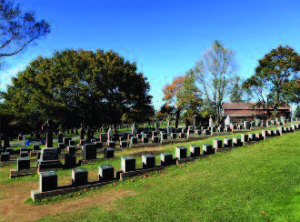
“When I read your book ‘Titaniko lietuviai,’ some long-forgotten memories stirred within me. I had heard about the ‘Titanic’ when only 5-6 years old. My grandfather used to regale me with stories about this boat, with tales so vivid, that it seemed like he himself was on the ship instead of his father, Antanas. In the city of Telšiai, at my grandparents’ home, an old chest was packed with newspaper clippings about the ‘Titanic’. For my grandfather, the ‘Titanic’ tragedy was like a sacred event, and he eagerly gathered information about it.
“My grandfather told me that Antanas was a cultured and educated person. He could speak many languages and he was eager to make a better life for himself and his family, and this hope pointed him toward America. And the ticket for a better life was a voyage on the ‘Titanic’. Antanas travelled in the steerage, in the lowest class, and I don’t think he registered under his real name. Because he was very curious and friendly, he roamed and befriended people from many parts of the ship. He did mention, that on the ‘Titanic’ there were other Lithuanians. Antanas mentioned that he had the opportunity to speak in his native tongue with them. Who these other Lithuanians were, and why and whereto they were travelling, he didn’t say.
“According to my grandfather, Antanas was interested in the practical and technical features of the ship, and he became interested in the supplies that were being shipped to America, especially automobiles and tractors. He noticed tractors from London, or perhaps just parts of tractors including tires and wheels. It turns out that these rambles and walks throughout the ship wound up saving his life. The night of the crash, he was deep in conversation with another passenger, and both were discussing new ideas and plans for life in America. According to my great grandfather Antanas, once the liner began to sink, the general atmosphere was one of great fear; something exceeding one’s worst nightmare. People were tearing at their hair, screaming, uncontrollably. He witnessed several people being shot.
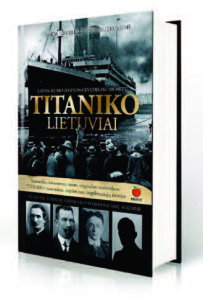
“Either by himself, or with one of his newly met friends, Antanas built a raft from several of these large tractor tires. Or maybe it was one very large tire on which he was able to support himself until someone took him into a lifeboat. Grandfather would relate, that his father Antanas, when he would recount the story of his rescue, would cry and shudder; during these terrible moments he had become like an animal overcome with survival instinct, and in lieu of helping others, focused on saving himself. Eventually, great-grandfather would become tiresome with his tales. He never forgot these horrible events; he remained unable to live with himself, and he would cry out at night, even after ten years had passed. He would walk alone at night, a specter with terrifying eyes, and repeat, ‘he who has not lived through the sinking of a ship has not experienced the taste of Hell.’
“On his return to Lietuva, great grandfather would maintain that perhaps it was easier for those who perished, as they did not have to come to terms with the nightmarish events of that night. For the remainder of his life, he would express ultimate respect for sailors and their ship captains. He never again would travel anywhere by boat. He would say that the horror of the sinking of the “Titanic” was comparable to the monstrousness of war, and perhaps even more terrible.”
The above excerpt was from a letter written by Eve Knopp, an Austrian of Lithuanian descent, addressed to Vaida and myself. The fascinating story of Antanas Mickevičius remains to be confirmed. Vaida and I have received similar letters, and we always try to obtain corroborating evidence. We try to maintain a relationship with those interested in the “Titanic” disaster via our Facebook page. The complete history of the “Titanic” shipwreck still has pages that remain to be written, and the fate of Lithuanians present on the “Titanic” may still be incompletely understood and revealed.
 DRAUGAS NEWS Lithuanian World Wide News in English
DRAUGAS NEWS Lithuanian World Wide News in English
